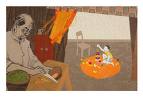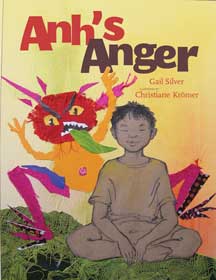By Phoebe Vreeland, The Children’s Book Review
Published: August 10, 2010
by Gail Silver (Author), Christiane Krömer (Illustrator)
Reading level: Ages 4-8
Hardcover: 40 pages
Publisher: Plum Blossom Books (August 11, 2009)
Source: Publicist
What to expect: Anger management, Buddhist influence
We all know how challenging it can be to help a child deal with the powerful energy of anger. No matter how deep our reserves of compassion and patience are as parents, we also seek tools. In Anh’s Anger, author Gail Silver offers traditional Buddhist technique for dealing with the emotion.
The story is a simple one. A young boy is absorbed in play, content building a tower of blocks while his grandfather prepares their dinner. Ahn does not want to be interrupted. After ignoring several requests to come to dinner, the boy melts down. Unable to articulate his feelings, they quickly progress from tears to anger. Finally, he yells mean words at his grandfather. Wise and steady, Grandfather politely asks Ahn to go to his room and sit with his anger. There he is surprised by the presence of a colorful and mischievous creature—his anger brought to life. The two “play” till they tire, then sit and breathe together. Change transpires. Grandfather returns and invites an articulate and apologetic Ahn to dinner.
 Illustrator Christiane Krömer blends silk and paper collage with brush and pencil drawings for great effect. She nicely depicts Ahn’s full range of emotion—contentment, tears, rage, surprise, remorse and serenity. Her choice of color and texture in the collage reinforce these emotions—watermarks echo Ahn’s tears and vibrant red and yellow dagger shapes amplify the boy’s rage.
Illustrator Christiane Krömer blends silk and paper collage with brush and pencil drawings for great effect. She nicely depicts Ahn’s full range of emotion—contentment, tears, rage, surprise, remorse and serenity. Her choice of color and texture in the collage reinforce these emotions—watermarks echo Ahn’s tears and vibrant red and yellow dagger shapes amplify the boy’s rage.
Upon first reading, my Western mind started throwing out criticisms of why this might not work as magically in real life. So I decided to do a bit of adult reading on the subject of anger. Ahn’s Anger is published by Plum Blossom Books, the children’s imprint of Parallax Press that offers young people books on mindfulness and Buddhism. The book clearly offers an Eastern approach and draws from the wisdom of an expert on the matter: Vietnamese Buddhist monk and peace-activist Thich Nhat Hanh.
Curiously, I found Hanh’s book Anger: Wisdom for Cooling the Flames in my own bookshelf. (“Hmmm, must be husband’s”, I murmur.) In it, Hahn instructs that the way we approach anger is to first accept responsibility for it and actually embrace it. “Your anger is not your enemy, your anger is your baby.” Our first task, he says, is to accept it as “a mother accepts her child.” Hahn views emotion as organic and therefore mutable. So, like refuse, which we change to compost, we can change our anger into love.
All this is comes through beautifully in Silver’s book for children. Clearly in choosing to call the character Ahn’s Anger, not simply Anger, she is teaching that part of transforming emotion is taking responsibility for it. The lively character is a collage of vibrant reds and yellows with pointy fuchsia ears, hairy red hands and a naughty green tongue. He surprises Ahn with his presence and says he is not a stranger, but a part of Ahn that comes out when things don’t go his way. Ahn begins to take charge of his anger when it invites him out of his room to wreak more havoc. Ahn obeys his grandfather’s command to stay in his room and suggest that they could play there. The two dance wildly and beat the floor like a drum. “Hmmm,” I hear my mind say, “Is this simply a choreographed tantrum?”
Once again, I return to Thich Nhat Hahn’s book Anger to find that he actually advises against physical expression of one’s rage such as beating a pillow, which he says is just rehearsing the undesired behavior. This was of particular interest to me. In one of my feeble attempts to help my four-year-old deal with her anger, I suggested instead of hitting me she could hit a pillow. To which she replied, “Okay, mommy can we get a pillow with your picture on it?” Okay, clearly children do not transfer emotion and hitting is not something I want her to rehearse! Yet, in Ahn’s Anger the boy and his anthropomorphized emotion do play wildly. Perhaps children need a physical release and so the author has the boy dance and drum. Whatever… it works. Soon Ahn is exhausted and ready to sit with this emotion.
I sense this next phase—the sitting with—is a part that families who do not practice mindfulness meditation might need help developing. The next two pages are spare, both in words and in illustration. Ahn and his anger simply sit and breathe together. Afterwards, the boy is clearly changed and remorseful. His anger is greatly diminished—the lively little creature is now shown deflated, slumped across the room with a faint smile. On the next page, when Grandfather gently knocks at Ahn’s door, the creature has been replaced by a flower. As Hahn teaches, our work is to transform this organic energy—the garbage of our anger—into the flower of compassion. “Yes”, I hear my mind saying, “I want to help plant these seeds, to encourage my little gardener.”
Also, I appreciate the gentleness and respect that Grandfather treats Ahn with—and I believe, because of this, it is eventually returned in kind by Ahn. This brings an uplifting element to the story. The far more common Western approach of showing who is the adult and banishing the child with a “time-out” never seems the right action to me—nor do I find it effective in the long run.
But the thing which finally sold me on Ahn’s Anger was when my daughter requested to hear it again. This may have much to do with the vibrant, lively depiction of Ahn’s Anger…but I would like to feel that it is because it offered her a better tool to deal with her anger than the pillow!
Add this book to your collection: Anh’s Anger

About the author: Gail is the author of the children’s book, Anh’s Anger, and contributing writer to The Expectant Mother’s Guide. She is the recipient of a 2007 Parents Choice Foundation award for the Cd, A Peaceful Place Inside, and recipient of the 2004 Parents Express enterprising Woman of the year award. The Yoga Child Children’s program is a two-time Best of Philadelphia award winner, providing yoga instruction to over 30 schools in the Philadelphia area.
More praise for Anh’s Anger:
“This is one of the best books we’ve ever seen on the issue of dealing with anger. Getting angry is normal. The question is how do you deal with your anger. In this incredibly story, Anh gets really angry and gets sent to his room to “sit with” his anger. Anh not only sits with his anger, he chats, dances, and plays with his anger. This story is simply amazing, healthy, beautiful….. a gem.”
—Reach And Teach
“…a valuable lesson for both adults and children in a story that takes the reader step by step through a process of mindfulness practice. . It can also be read jointly by families as a teaching and discussion tool, with the appearance, shrinking and disappearance of the monster serving as a representation of the process of facing, addressing and transforming our relationship with anger. And it is not to be underestimated as a book suitable for adults; it artfully shifted my state of mind.”
—Felicia M. Tomasko, RN, LA Yoga Magazine
“a yoga-inspired tale, promoting deep breathing as the ideal way to regain control during a tantrum,”
–The New Yorker, October, 2009


3 Comments
Pingback: Anh’s Anger | momgrooves.com
I really appreciate this review. I had to write about the book on my mom blog just share our new favorite book. I linked to this page so people could see a proper review. I’m also thrilled to have found this site!
I’m so glad that you are thrilled about finding TCBR! We love Phoebe’s reviews (this one in particular) and are happy that you do, too.